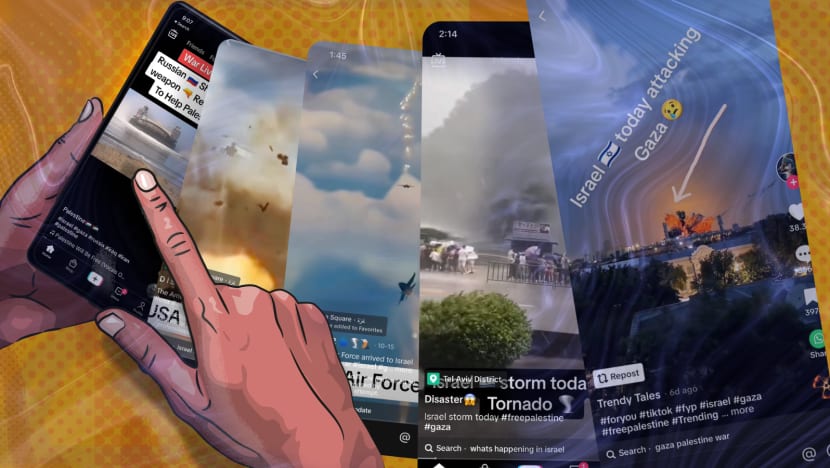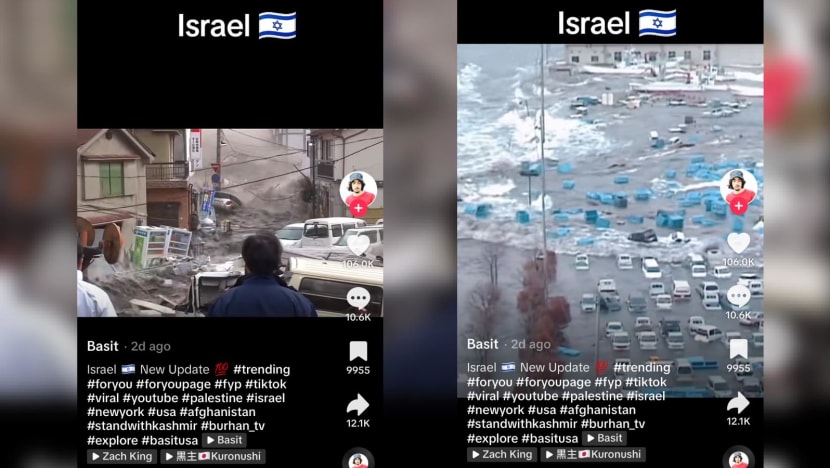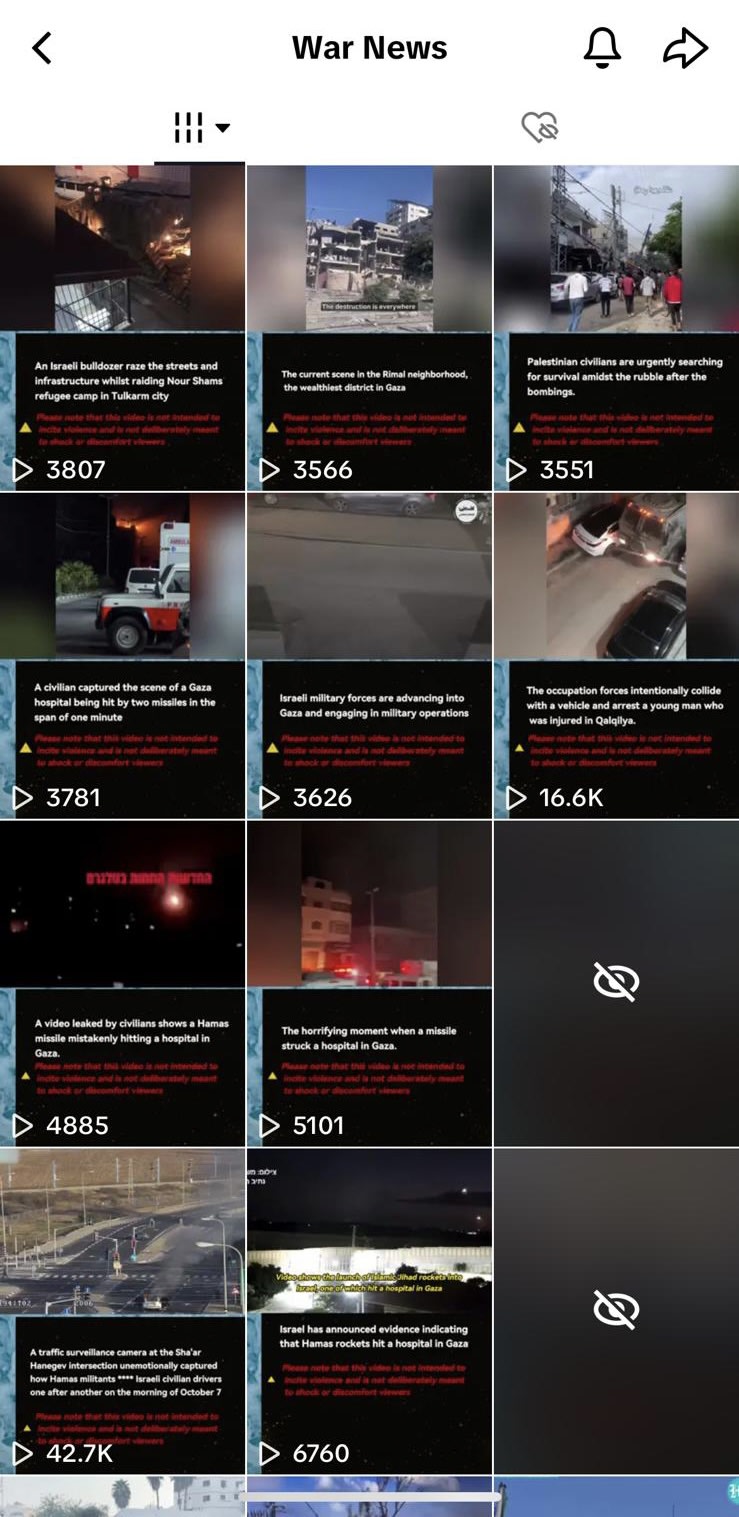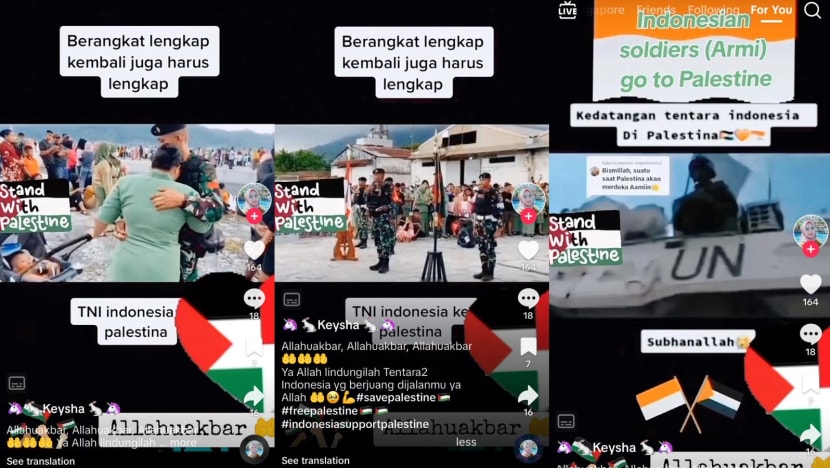IN FOCUS: How fake news on Israel-Hamas stokes outrage, hatred and ‘potential for violence’ on Southeast Asian TikTok
A CNA experiment on TikTok uncovers a stream of misleading content on the Middle East conflict – one that if left unchecked, could have “dangerous” repercussions for people in Indonesia, Malaysia and Singapore.

A TikTok user scrolling through videos on the Israel-Hamas war. (Illustration: CNA/Rafa Estrada)

This audio is generated by an AI tool.
SINGAPORE: Mr Mohamed Aliff Tusliman is on a mission to find unfiltered, unbiased and “more real-life content” on the ongoing Israeli-Palestinian war.
The Singaporean’s compass of choice? TikTok.
The dominant social media app provides information “recorded live or posted by individuals who are actually on the ground”, said Mr Aliff.
For him, it's where “there are individuals, on their own accord, giving context on what's happening, and these are independent people not related to any news agencies”.
Yet the 38-year-old, who works in a digital marketing agency, doesn’t believe everything he sees on TikTok.
His main “For You” page, fuelled by the platform’s engagement-driven algorithm, recently fed him a video of footage from the Middle East conflict, showing bloodied and injured children being pulled from rubble.
The clip’s caption, in Hebrew, said Palestinian militant group Hamas was to blame, and contained the hashtag #freeisrael.
Mr Aliff was sceptical. The scale of devastation displayed in the video seemed unlikely to have unfolded in Israel, which has retaliated to an Oct 7 Hamas blitzkrieg by unleashing relentless strikes on the Gaza Strip. Medical authorities in the Palestinian territory have put the death toll at over 8,000 people, including more than 3,000 minors.
Mr Aliff suspected that the victims in the video were actually Palestinians – and true enough, he found identical footage posted by the Eye On Palestine Instagram page, a prominent, verified account sharing experiences of people weathering Israeli attacks in Gaza.
On the other hand, he has also seen misinformation on TikTok supporting pro-Palestinian narratives, such as a video claiming to show widespread destruction in Gaza when it was actually a scene from an earthquake in Afghanistan.
“For me, a general rule of thumb is to never 100 per cent believe anything on social media regardless of the platform, especially with all the artificial intelligence tools (around),” said Mr Aliff.
A week-long CNA experiment, on top of reports from TikTok users and misinformation experts in Indonesia, Malaysia and Singapore, has identified a steady stream of inaccurate content on the Israel-Hamas war spreading on the platform.
While the proliferation of fake news online during geopolitical tensions is not new – an issue which also surfaced during the ongoing Russia-Ukraine war – analysts said the Israel-Hamas conflict takes on a different, perhaps more pernicious dimension in Southeast Asia.
Large Muslim populations in the region might identify more with the Palestinian plight and feel compelled to raise awareness and elicit sympathy, observers noted – and in the process, unwittingly share falsehoods.
Their intentions might start off benign, but experts warned it could lead to real-world consequences such as the rousing of emotionally charged sentiments and flashpoints among religiously diverse groups.
And while social media platforms are making efforts to combat the deluge of lies and deception, significant challenges remain – not least accusations of “shadowbanning” as a means of censorship, as well as algorithms that encourage “hot takes” and fuel polarisation.
TIKTOK IN THE SPOTLIGHT
In the immediate aftermath of Hamas’ surprise attack in early October, over 40,000 fake profiles took part in the conversation on platforms like TikTok, Facebook, Instagram and X, according to scans by Israel-based social media threat intelligence company Cyabra.
Content created by these fake profiles received more than 371,000 engagements and potentially reached 531 million profiles in just two days.
While just one of several social networks where misinformation has circulated, TikTok is of particular interest for its increasing prominence as a news source in Southeast Asia, as well as its growing role as a search engine for Gen Z youths.
An annual report by the Reuters Institute for the Study of Journalism found that nearly a quarter of Malaysians turn to TikTok for news, up nine percentage points from the previous year; while 22 per cent of Indonesians do so, in an increase of six percentage points.
While the proportion was smaller in Singapore (12 per cent), this was after a spike of five percentage points from last year, the biggest increase among most-used platforms in the country.
Narrow it down to 18- to 24-year-olds in Singapore and the figure swells to 22 per cent using TikTok for news.
This popularity with younger folks is widespread, and growing: Around the world, a fifth of 18- to 24-year-olds use it to access news, a five percentage point rise from before.
Meanwhile, the proportions of people in the three countries using services like Facebook and Twitter – before it changed its name to X – for news have been declining.
Mr Harris Zainul, deputy director of research at Malaysia’s Institute of Strategic and International Studies (ISIS), said the shift towards TikTok for news speaks to a larger change in media consumption habits.
“Short-form videos that are algorithmically determined to suit your preferences can be more engaging than the long-form text or video favoured by mainstream media,” he added.
"Information from social media users can also be perceived to be more authentic, especially compared to traditional media which has been criticised to be biased in their reporting.”
For this article, a CNA journalist in Singapore created a TikTok account and used it just to watch and “like” content related to the Israel-Hamas war. Search terms like “Palestine”, “Israel” and “Israel-Hamas war updates” were used, and initially yielded videos from established media outlets like CNN and Sky News.
But in the week that followed, the journalist started seeing clips on her For You feed that clearly contained misinformation. They often featured legitimate footage from past military conflicts or tragedies – but paired with misleading captions.
Video game visuals, digitally manipulated natural disasters and even pseudo supernatural events also popped up periodically. Some of these clips were posted by accounts launched just days after the conflict began.
In one video posted on Wednesday (Nov 1), footage of an “update” from Israel turned out to be that of a severe earthquake and tsunami that struck Japan in 2011. It still garnered 5.5 million views, 106,000 likes and more than 12,000 shares.

Elsewhere, a TikTok profile named War News posted a video – still up online – purportedly showing Gaza being bombed by Israel at night. Multiple commenters have since corroborated the footage to be of the US attacking Iraq 20 years ago.
Another War News video showed the Rafah crossing – which connects southern Gaza to Egypt – being blown up. This has not happened, and the crossing reopened on Wednesday.
The War News page remains online since it began posting on Oct 11, and has over 13,000 followers as well as almost 100,000 likes across its videos.
Its clips have a consistent, polished aesthetic mirroring a mainstream media outfit. The only hint of who or what runs the account is a link to an obscure YouTube profile with four Vietnamese-language videos.

WHO IS SPREADING FAKE NEWS?
It’s not easy to tell who might be behind social media accounts putting out or sharing falsehoods to sway public opinion, said a spokesperson for Singapore-based Black Dot Research, which runs a self-funded fact-checking outfit.
“From our observations, misinformation and disinformation on the conflict largely originates from outside Singapore,” the spokesperson said. “In Singapore, we have observed that members of the public are often only reposting content related to the conflict, rather than creating it.”
Misinformation refers to any kind of wrong or false information, while disinformation refers to misinformation that is knowingly or intentionally spread.
A day after the Hamas attack, a Singapore-based TikTok account with almost 60,000 followers posted a video on how Palestinians were apparently gaining an edge in the conflict with Israel.
CNA’s checks online showed the account, under the handle @ryanle.ee, belongs to a 16-year-old Singaporean who regularly puts up pro-Palestinian content.
The video he posted included a screenshot of an X post claiming a top Israeli general had been captured by Hamas. But this was debunked by news agency Associated Press, which reported that the general had been spotted in both a photo and video of top Israeli military officials in discussion.
The Singaporean did not respond to a direct message on TikTok requesting comment.
Malaysia-based TikTok accounts have also shared inaccurate information on the Israel-Hamas war. One of them, @adamofficial64, posted on Oct 15 a video purporting that Malaysia was sending troops to Palestinian territory.
Malaysia’s military and government fact-checking website have debunked the video and clarified that the footage was from a United Nations (UN) mission to Lebanon in 2022. The video was then taken down.
@adamofficial64 also did not respond to CNA’s request for comment.
Indonesian Maula Hudaya, 26, estimated that about 30 per cent of TikTok videos he’s seen on the Israel-Hamas war appeared to contain inaccurate content.
He pointed CNA to a video by an Indonesia-based account, showing Indonesian troops sharing tearful goodbyes with loved ones, even though the footage clearly depicts an unrelated UN mission. None of the comments on the video, which was layered with visuals of Islamic religious elements, seemed to question its authenticity.

“Most people here don’t really care about whether the videos they share are 100 per cent accurate," said Mr Maula, who teaches at a university.
"Their main goal is actually to emotionally engage the audience through supporting the struggle of the Palestinian people."
IDENTIFYING WITH SUFFERING
Most Indonesian TikTok users guilty of sharing fake news on the war are regular, pro-Palestinian Muslims, said Ms Ika Ningtyas, fact-checking coordinator at Indonesian news outlet Tempo.
“They share the content to express their feelings and to defend Palestine without verifying them properly,” she told CNA.
Ms Ika also said Indonesians were supporting the Palestinians not only because of their shared religion, but because they feel “Israel's retaliatory actions that (could) lead to genocide should be condemned”.
People sharing fake news could be motivated by sympathy and the need to spread awareness, call others to action or indicate their stand on the issue, said the Black Dot spokesperson.
The agency has seen misinformation appealing to religious affiliations among diasporas and the wider international community.
This includes a claim that a Greek Orthodox church in Gaza was bombed by Israeli forces, which Black Dot said might have been an effort to garner support from that particular Christian community.
The church clarified on Oct 10 that it was not only intact but also actively helping civilians in the area. However, on Oct 19, it was hit by an airstrike which caused serious damage and death, according to the Associated Press.
“Muslim populations in Southeast Asia may well identify with the suffering of those who share their religion in Gaza, just as some Jewish and Christian groups support Israel in accordance with their religious beliefs,” the Black Dot spokesperson said.
“While we have not observed any significant differences in the information environment in Southeast Asia, such differences pose a potential flashpoint in Singapore and across any society where diverse religious denominations co-exist.”
Dr Shashi Jayakumar, executive director of the Singapore-based SJKGeostrategic Advisory, observed that social media content on the war has roused sentiments among the Malay-Muslim population in Singapore.
“They have come up with their own points of view, short videos, memes, etc which are not in the same category of misinformation,” he said.
“It seems to me that, arising from Hamas' attack into Israel and Israel's response, the ongoing episode has to many Muslims (including those in Singapore) reawakened or rekindled a sense of awareness concerning the plight of the Palestinians, and a reawakening of interest in what has happened to them since 1948.”
That year marked the first war of the Israeli-Palestinian conflict, which displaced around 700,000 Palestinians and led to the founding of the Jewish state.
A Malaysian TikTok user who regularly posts videos of himself commenting on the Israel-Hamas war said it was a situation where proponents of either side were seeking to push their narratives.
“To achieve this, they need to create misleading news to cloud the public eye,” said Muhamad Nur Thaqib Shaker, 32.
Those who support the Palestinians are likely to share videos that supposedly show cruelties committed by Israeli forces in Gaza.
And those who support the Israelis are likely to share videos that manipulate the history of the Middle East conflict and supposedly show Hamas’ atrocities against Israeli hostages, said the freelance writer.
Mr Thaqib spoke of the “dangerous” implications of letting misinformation on TikTok spread unabated, including the potential escalation of similarly inaccurate or emotionally charged arguments.
People who share fake news are raising tensions, he said.
“POTENTIAL FOR VIOLENCE”
Warring parties in modern conflicts worldwide have long used the internet to try and win over hearts and minds, often mixing truth with falsehoods.
Both Israeli authorities and Hamas have been accused of spreading misleading propaganda online.
Some countries like Australia and Singapore have enacted laws against foreign interference, with the latter arguing that social media companies cannot be left alone to weed out hostile information campaigns.
Dr Jayakumar said it was difficult to tell if the spike in Israel-Hamas war disinformation on social media was due to organic or state-sponsored subversion.
“I note however that FICA has not been employed at this point,” he told CNA, referring to Singapore’s Foreign Interference (Countermeasures) Act, a law meant to deal with hostile information campaigns by foreign entities to interfere in domestic politics.
Black Dot has observed misinformation spreaders looking to engage in hostile information campaigns by weaponising false information to intentionally mislead or deceive audiences.
These could include state actors and other organisations with vested interests in the Israel-Hamas conflict, its spokesperson said.
“Campaigns to control the public narrative are not only being directed outwards towards the global community, but also internally as residents of the region ponder their next actions and how to attribute responsibility for the events transpiring around them,” she added.
Both foreign and domestic elements have been opportunistically spreading false or misleading information on the war, just like for Russia’s invasion of Ukraine in February last year, said Ms Julia Lau, a senior fellow and co-coordinator of the Indonesia Studies Programme at Singapore’s ISEAS-Yusof Ishak Institute.
But this is occurring to “much more devastating effect” now, given the resonance of the Palestinian issue for regional Muslims, she added.
Ms Lau said Indonesian researchers studying both older platforms like YouTube and newer ones like TikTok are warning of "the potential for violence if online content – false or otherwise – mixes with offline rumours to lead to mob attacks”.
Indonesia’s Ms Ika said that while her fact checking outfit has yet to find nefarious aims behind the misinformation it has debunked so far, their spread could still lead to excessive hate aimed at Israelis - some of whom she noted were also victims – and the countries that support them.
“Discrimination may lead to violence against Israeli civilians who are not part of the war and affected by the conflict, including Jews living in other countries,” she said.
Some stark, real-world consequences of fomented outrage and hatred have already unfolded.
In the US, a 71-year-old man was charged with murder and hate crimes after allegedly stabbing a six-year-old boy to death and seriously wounding his mother. Both victims were targeted because they were Muslim and also due to the ongoing conflict, authorities said.
And France has been put on its highest security alert after a teacher was killed by a suspected Islamic State radical, and bomb threats forced the evacuation of the Louvre museum. Authorities said the attack on the teacher bore a link to events in the Middle East.
WHAT AUTHORITIES, TIKTOK SAY
The European Commission has asked Meta – which owns WhatsApp, Facebook and Instagram – and TikTok about how they curb misinformation about the war. It is also investigating X for allegedly disseminating bogus information.
In response to CNA’s queries, Singapore’s Ministry of Communications and Information said it has “emphasised to social media services the need to step up content moderation efforts during this period, taking into consideration local sensitivities”. It did not elaborate.
The ministry acknowledged that social media users in Singapore could be at “heightened risk of being exposed to harmful online content and misinformation”; while urging the public to be vigilant, fact check and not circulate information if unsure about its credibility.
CNA also reached out to the infocomm authorities in Malaysia and Indonesia for their comments.
In its most recent update on its website on Friday, TikTok said that since the war broke out, it has removed more than 925,000 videos in the conflict region for violating its policies around violence, hate speech, misinformation and terrorism, including content promoting Hamas.
Globally, TikTok has removed 50,000 videos with “dangerous misinformation” during the same period, as well as more than 24 million fake accounts and more than half a million bot comments on content under hashtags related to the war.
The platform, owned by Chinese tech firm Bytedance, previously said it had added more moderators who speak Arabic and Hebrew to review content related to the conflict. It also works with external fact checking organisations like Agence France-Presse.
Apart from content moderation, recent media articles and academic studies have reported that TikTok’s algorithm does not favour news, and that misleading videos on the platform can “circulate quickly thanks to their shock value”.
In response, a TikTok spokesperson told CNA the notion that the platform would benefit from shock value content is “baseless”.
“We remove content that violates our policies against harmful misinformation and have policies against shocking content, which we would either remove or make ineligible for recommendation into the For You feed,” the spokesperson said.
The spokesperson added that TikTok further reviews content as it gains popularity on the app, in order to prevent the recommendation of videos that violate its rules.
Another article in October said users were paying TikTok as little as US$7 to promote and spread misinformation on the Israel-Hamas war.
A TikTok spokesperson said the platform does not support keyword targeting or topic-based advertising and that it blocks search terms violating its policies. “Israel” and “Palestine” have also been added to a list of search terms that are ineligible for advertising.
“NOT NEUTRAL PLATFORMS”?
During CNA’s week-long observation of Israel-Hamas content on TikTok, some fake videos that the journalist came across were eventually taken down.
But others remained online, continuing to rake in views, comments and shares; and exemplifying the whack-a-mole nature of content moderation.
Mr Harris from Malaysia called for social media apps to face more regulatory scrutiny, and to be more transparent about how they moderate content.
“The argument that they are merely neutral platforms is manifestly untrue, and those forwarding this argument today - after everything that has happened - are disingenuous,” he told CNA.
Black Dot pointed out, however, that for platforms like Meta, attempts to stem fake news have been met with scepticism and accusations of “shadow banning” as a means of censorship.
A "shadow ban" is when a social media user is blocked or has their reach reduced without their knowledge. This typically results in others not being able to view their posts or comments.
This narrative has been weaponised by some actors to push selective narratives, the Black Dot spokesperson said.
And it means that a heavy-handed approach - through regulation or screening - may not be the best, as it could lead to the public viewing either the state or media organisation as no longer impartial.
“The approach should instead seek to tap on extensive outreach, monitoring, and education,” the spokesperson added. “It is important to identify misinformation early, verify the validity (or lack thereof) of the claims expeditiously, and share the facts through trusted sources to mitigate the spread and reach of false content.”
Dr Gulizar Haciyakupoglu, a research fellow at Singapore’s S Rajaratnam School of International Studies (RSIS), said a multifaceted problem like disinformation cannot be resolved with a single solution or by a single entity.
She noted that even those who have undergone media literacy training and have the skills to combat misinformation can fall prey to biases or emotions.
A diverse suite of countermeasures, including fact-checking, legal levers and prebunking – being educated beforehand – could be employed to clean the information environment and arm people with accurate information, said Dr Gulizar.
Editor's note: An earlier version of this article said the claim of a Greek Orthodox church in Gaza being bombed was debunked. That was on Oct 10. On Oct 19, the church was in fact hit by an airstrike, according to media reports.
How TikTok users can better discern info on Israel-Hamas
TikTok users have commented on how it can be difficult to ascertain the truth of what they see on the platform, especially when it is populated by self-proclaimed experts and talking heads analysing or opining about the conflict.
The Center for Countering Digital Hate, a British non-profit organisation, said the first principle is to not share content that you cannot verify.
Social media users should also check the publication date of a piece of content, and be sceptical of artificial intelligence or doctored images, it added.
Users can also cross-check with a diverse and reliable variety of sources.
Journalist Shayan Sardarizadeh, who works for the BBC’s disinformation team, advised users to check the source and language of the content, such as whether it is sensationalist or full of loaded terms.
To verify a video, users can also zoom into details like street signs, shop signs or billboards, and check the language used.
A tip offered by Mr Sardarizadeh was to run a screenshot through Google's reverse image search function, to see when it was first posted.
Mr Harris from ISIS Malaysia said social media users should recognise that they could be attracted to or believe certain types of information around the war, due to their emotions and implicit bias.
“As bystanders with no access to primary information, there is a real possibility of getting things mistaken – and correcting oneself should not be viewed as abandoning the cause or taken as a sign of wavering support,” he added.
People should also be wary of sources portraying the war in black-and-white terms, said Black Dot, as well as of "those who view people on the other side of the conflict as less deserving of health, safety and humane treatment”.






















